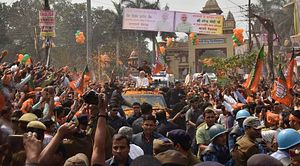Indian Prime Minister Narendra Modi has done it again. As results emerged from the early 2017 state assembly elections, it quickly became clear that he had decimated his political adversaries in ways that are difficult to even describe. regional parties are left scurrying for cover while the main national opposition party, the Indian National Congress, has lost so badly that it’s not even pretending to be in competition. Since 2014, India has been undergoing Modi-fication and there are few who are challenging this phenomenon at the moment.
The most populous state in the country, Uttar Pradesh, has voted for Modi’s Bharatiya Janata Party (BJP) in a landslide which the country has not seen in decades. The BJP emerged victorious in Uttar Pradesh by a resounding margin in what can only be termed as another ‘Modi wave.’ The BJP, along with its alliances, has won 324 seats out of 403 in the state assembly, the biggest majority for any party in Uttar Pradesh since 1980. The result mirrors the 2014 Lok Sabha result, but what is striking is that around three years into its term in New Delhi, the BJP has retained its vote share from 2014. Modi remains as popular, if not more, than what he was in 2014 and his credibility remains at an all time high. The election result therefore represents a seismic shift in Indian politics. Modi has reaffirmed his credentials as the greatest political leader of his generation and, at this stage, his victory in the 2019 parliamentary elections seems almost foreordained.
Uttar Pradesh has always been the prized catch in Indian politics and the BJP has been struggling to come to power on its own in the state. To achieve that milestone, Modi has taken political risks and he has reaped handsome political dividends. Demonetization was one such risk. Modi’s move to go after black money by declaring 500 and 1000 rupee notes invalid took everyone, including his cabinet, by surprise as 86 percent of the cash in circulation became instantly worthless. Considering that 90 percent of India’s economy is cash-based, this is was huge decision. The danger was that if demonetization didn’t help working people get on with their lives and rebuild the momentum the local economy had lost, Modi would have lost his core support base – the aspirational India. There was a concerted attack on the government by opposition parties, which sought to make political capital of people’s hardships, but the the poll outcome belied apprehensions about the political fallout of Modi’s decision.
Modi turned the narrative around on demonetization very quickly by promoting the move as one way of ending systemic corruption in the country. Where his critics assailed him and questioned the economic logic behind the move, he managed to convince the poor that, for the first time, someone was targeting the corrupt and rich sections of the nation.
The opposition made the regional elections a referendum on demonetization and Modi succeeded in winning the political argument. He is a master communicator and his connection with ordinary Indians allowed him to pip his critics to the post. By so doing, he managed to bury the old style politics of caste-based alliances. This was something that he had done in 2014 as well, but his opponents thought that was a flash in the pan. They continued to focus on sectarian arithmetic, but Modi took it head on in 2017 and demolished them once again. The power of his personality swept away the caste allegiances in one of the most caste-ridden states in India. His popularity has trumped every kind of identity politics for the moment.
His comrade in arms in this endeavour has been Amit Shah, the BJP’s president, who has once again proved to be a master political strategist. It has been under his direction that the BJP has managed to emerge as an umbrella party in the heartland of the country. Shah’s organisational skills perfectly complement Modi’s mass appeal, making the duo a formidable force in the Indian polity.
There is now an expectation that this mandate will reinvigorate the Modi government to accelerate economic reforms and to govern with renewed vigor. If the BJP returns to power in 2019, its ability to push through its legislative agenda would be smoother in the Upper House of parliament, the Rajya Sabha, because the numbers in the Uttar Pradesh assembly will enable it to send more MPs to the Upper House. The BJP today faces no real challenge in Indian politics and Modi’s triumph is only his own. For Modi’s opponents now stitching up a grand national alliance seems to be the only alternative left, but paradoxically that may end up strengthening Modi himself.
How the Indian polity readjusts to the phenomenon that is Modi today will be fascinating to watch, not only because the high stakes for all major actors involved, but also because in more ways than one the future of Indian democracy too is at stake.

































